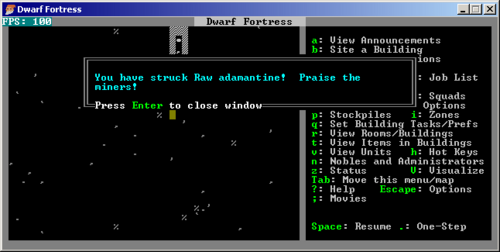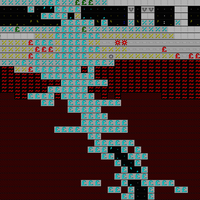- v50 information can now be added to pages in the main namespace. v0.47 information can still be found in the DF2014 namespace. See here for more details on the new versioning policy.
- Use this page to report any issues related to the migration.
Difference between revisions of "v0.31:Raw adamantine"
(fixed grammar error) |
|||
| Line 1: | Line 1: | ||
{{quality|Masterwork|18:25, 8 November 2010 (UTC)}}{{stonelookup/0}}{{av}} | {{quality|Masterwork|18:25, 8 November 2010 (UTC)}}{{stonelookup/0}}{{av}} | ||
| − | The ore of {{L|adamantine}} is absurdly valuable, and can be processed into one of the most valuable {{L|material}} in the game, both in monetary | + | The ore of {{L|adamantine}} is absurdly valuable, and can be processed into one of the most valuable {{L|material}}s in the game, both in monetary value and utility. Its discovery is both a boon and a bane; it has a massive {{L|value}} even unrefined, and weapons and armor made from it are very likely among the best possible. Its high melting point means you can easily use it to build magma-safe mechanisms and floodgates, but this is not recommended due to its scarcity and value in other items. |
Raw adamantine has a {{L|Item_value#Material_multipliers|Material Multiplier}} of x250. For a comparison to other mined materials, generic {{L|stone}} has a MM of x1, {{L|obsidian}} x3, {{L|native silver}} x 10, {{L|native gold}} x30, and {{L|native platinum}} x40. Processed {{L|adamantine}} "metal" has a multiplier of x300, the highest in the game of any {{L|material}}. | Raw adamantine has a {{L|Item_value#Material_multipliers|Material Multiplier}} of x250. For a comparison to other mined materials, generic {{L|stone}} has a MM of x1, {{L|obsidian}} x3, {{L|native silver}} x 10, {{L|native gold}} x30, and {{L|native platinum}} x40. Processed {{L|adamantine}} "metal" has a multiplier of x300, the highest in the game of any {{L|material}}. | ||
Revision as of 22:49, 27 August 2011
| ||||||||||||||||||||||||||||||||||||
| Uses | ||||||||||||||||||||||||||||||||||||
|---|---|---|---|---|---|---|---|---|---|---|---|---|---|---|---|---|---|---|---|---|---|---|---|---|---|---|---|---|---|---|---|---|---|---|---|---|
|
| ||||||||||||||||||||||||||||||||||||
| Properties | ||||||||||||||||||||||||||||||||||||
| ||||||||||||||||||||||||||||||||||||
| This article is about an older version of DF. |
The ore of Template:L is absurdly valuable, and can be processed into one of the most valuable Template:Ls in the game, both in monetary value and utility. Its discovery is both a boon and a bane; it has a massive Template:L even unrefined, and weapons and armor made from it are very likely among the best possible. Its high melting point means you can easily use it to build magma-safe mechanisms and floodgates, but this is not recommended due to its scarcity and value in other items.
Raw adamantine has a Template:L of x250. For a comparison to other mined materials, generic Template:L has a MM of x1, Template:L x3, Template:L x 10, Template:L x30, and Template:L x40. Processed Template:L "metal" has a multiplier of x300, the highest in the game of any Template:L.
Adamantine is so valuable, both in price and usefulness, that a special message pops up when your miners discover a vein of it.
Location
Every map can contain adamantine, regardless of the location. Very small maps can lack adamantine veins, usually however multiple veins are present (~1 per 4 embark squares). If an adamantine veins is located in an embark square, it will be in the center of this square. Adamantine veins can appear on the surface, but will be bordered by a great magma sea.(Confirmed in adventure mode)
More specific statistics, from this forum post:
- Word of Toady, and supported by all the careful research I've seen so far, is that there is one blue spire generated in every 2x2 embark grid, randomly placed amongst the four embark squares. Every 16x16 region square therefore has exactly 64 blue (and one special HFS). A 2x2 embark aligned to the grid will have exactly one blue spire. A 2x2 embark offset may have as few as none or as many as four blue spires. Over all the possible configurations of 2x2 embarks, your odds are as follows (rounded): zero blue, 20.4%; one blue, 60.6%, two blue, 17.8%, three blue, 1.8%, four blue, 0.1%, with an average (not surprisingly) of one blue; you also have a chance of special HFS of about 1.6%.
- A 3x3 is guaranteed (barring serious program bugs) to have at least one blue, has an average of 2.25 blue, and a max of four blue, with a special HFS chance of about 3.5%. An unaligned 4x4 still has a minimum of one blue, but an average of four blue, and a max of nine blue; with special HFS chance of about 6.3%; aligning it with the grid gives you exactly four blue. Moving up to a 5x5 increases the minimum blue to four, with an average of 6.25 and a max still of nine; the special HFS chance is 9.8%. If you're planning one making the HFS a major part of your fortress and don't cheat with reveal, an aligned 4x4 is the smallest you can generate that is guaranteed to have multiple blue (and therefore a high chance of multiple entrances, reducing the risk that one of the spires will not be traversable).
Storage
Raw Adamantine is stored in stone stockpiles with "Raw Adamantine" enabled in that stockpile's 'other stone' category. Once extracted, adamantine strands will be stored in Cloth stockpiles which have the appropriate materials enabled.
Veins and Mining
It's worth noting that a tile of Raw adamantine, when mined out, will always produce a stone, regardless of the skill of the miner. Raw adamantine veins, in contrast to usual ore veins, span z-levels nearly exactly straight upwards, and are thicker than many gem clusters. Adamantine veins can span from 5 to 30-40 z-levels, sometimes even significantly more. Despite being impossibly strong, a simple copper pick works fine for mining it out, and the vein is full of raw adamantine ripe for the diggin'. Just make sure you don't dig too deep...
One serious downside to mining veins of raw adamantine is that some veins are hollow, and digging into the hollow section will eventually lead to a certain Template:L, triggering Template:L which can and usually will wipe out even a mature, heavily defended fortress. On the bright side, the location of all adamantine veins will be revealed at this time.
Adamantine can be found in vertical pillars in the Template:L. This makes mining difficult, as one must either drain the area around the pillar to mine the pillar fully, or in cases of thicker pillars, mine out only the interior without breaching the exterior layer (and thus flooding the interior with magma). However, with the access to vast amounts of water almost guaranteed on any map thanks to underground lakes, it might be possible to use selective flooding to cool the magma around the adamantine, and build walls of obsidian around them.
(end spoilers)
[INORGANIC:RAW_ADAMANTINE]
[ITEM_SYMBOL:'*']
[THREAD_METAL:ADAMANTINE:100]
[STATE_NAME_ADJ:ALL_SOLID:raw adamantine]
[STATE_NAME_ADJ:LIQUID:molten raw adamantine]
[STATE_NAME_ADJ:GAS:boiling raw adamantine]
[DISPLAY_COLOR:3:7:1]
[TILE:156]
[MATERIAL_VALUE:250]
[SPEC_HEAT:7500]
[MELTING_POINT:25000]
[BOILING_POINT:50000]
[SOLID_DENSITY:200]
[LIQUID_DENSITY:2600]
[MOLAR_MASS:55845]
[IMPACT_YIELD:2500000]
[IMPACT_FRACTURE:3000000]
[IMPACT_STRAIN_AT_YIELD:0]
[COMPRESSIVE_YIELD:2500000]
[COMPRESSIVE_FRACTURE:3000000]
[COMPRESSIVE_STRAIN_AT_YIELD:0]
[TENSILE_YIELD:2500000]
[TENSILE_FRACTURE:3000000]
[TENSILE_STRAIN_AT_YIELD:0]
[TORSION_YIELD:2500000]
[TORSION_FRACTURE:3000000]
[TORSION_STRAIN_AT_YIELD:0]
[SHEAR_YIELD:2500000]
[SHEAR_FRACTURE:3000000]
[SHEAR_STRAIN_AT_YIELD:0]
[BENDING_YIELD:2500000]
[BENDING_FRACTURE:3000000]
[BENDING_STRAIN_AT_YIELD:0]
[DEEP_SPECIAL]
[MAX_EDGE:1000] no swords until you can pick mats
[ITEMS_HARD]
[IS_STONE] |
| Sedimentary | |||||
|---|---|---|---|---|---|
| Igneous |
| ||||
| Metamorphic | |||||
| Ore | |||||
| Economic | |||||
| Other |
Alunite · Anhydrite · Bauxite · Borax · Brimstone · Chromite · Cinnabar · Cobaltite · Cryolite · Graphite · Hornblende · Ilmenite · Jet · Kimberlite · Marcasite · Mica · Microcline · Olivine · Orpiment · Orthoclase · Periclase · Petrified wood · Pitchblende · Puddingstone · Pyrolusite · Realgar · Rutile · Saltpeter · Serpentine · Slade · Stibnite · Sylvite · Talc | ||||

